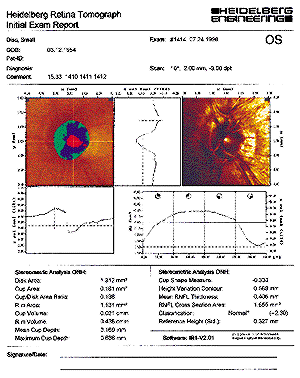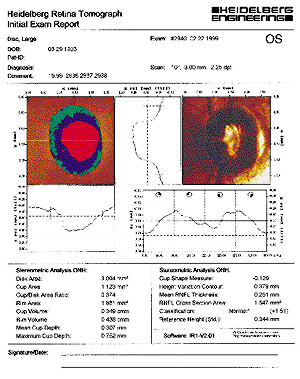Studies show peripapillary atrophy may indicate glaucomatous optic neuropathy
The appearance of the optic disc is often the most important sign clinicians use in diagnosing glaucoma. The classic signs of glaucomatous optic neuropathy include thinning of the neuroretinal rim (shape), deepening of the optic cup, the vertical shape of the optic cup, large cup/disc ratios, asymmetry between the cup/disc ratios of the two eyes and optic disc splinter hemorrhages.
Recently, several studies have been published that allow us to add peripapillary atrophy (PPA) to the list of signs of glaucomatous optic neuropathy. In addition, with new technologies that accurately measure the optic disc size, we are able to understand its relationship to the size of the optic cup and consider its use clinically.
For many years, there have been reports of an association between PPA and glaucoma. Elschnig and Bucklers described the appearance of an atrophy around the optic disc 70 years ago and termed it “halo glaucomatosus.” Other clinicians have also described the clinical appearance of PPA as well as correlated the extent and location of atrophy to glaucomatous visual field loss. Still, until recently, we were not sure of the exact meaning of PPA. Did PPA begin as glaucoma develops and progress as the condition worsens? Or did PPA exist before glaucoma ever occurred, and was it a factor leading to the optic nerve and nerve fiber layer being more easily damaged in glaucoma?
Enlargement of PPA
| |
|
Recently, several articles have been published that demonstrate an association between PPA and glaucomatous damage. In particular, a relationship has been found between the development of glaucomatous damage and enlargement of PPA. From these studies, it appears that PPA is similar to optic disc cupping, changing as the condition worsens and correlating to field loss. PPA thus becomes another factor to monitor and is useful in deciding who may be developing glaucoma.
Jonas and colleagues evaluated 691 normal eyes, 1,081 eyes with glaucoma and 31 eyes with ocular hypertension. PPA was larger and occurred more often in the group with glaucoma (1.07 ± 0.83 mm2) compared to the normal group (0.55 ± 0.64 mm2) (Jonas JB, Fernandez MC, Naumann GO. Glaucomatous parapapillary atrophy. Occurrence and correlations. Arch Ophthalmol 1992; 110(2):214-222). PPA was larger as the neuroretinal rim area decreased and showed a spatial correlation to visual field loss.
Tezel and colleagues published a retrospective analysis of 350 eyes of 175 patients with ocular hypertension (Tezel G, Kolker AE, Kass MA, Wax MB, et al. Parapapillary chorioretinal atrophy in patients with ocular hypertension. I. An evaluation as a predictive factor for the development of glaucomatous damage. Arch Ophthalmol 1997; 115(12):1503-1508). The objective was to determine if PPA was associated with the development of glaucomatous optic nerve and visual field loss. A follow-up period of at least 10 years was used, and 98 eyes of 53 patients developed optic disc damage and/or visual field loss. PPA, a large PPA area-disc area and zone beta area-disc area were all associated with conversion to glaucoma.
In another study, Tezel and colleagues again retrospectively evaluated 350 eyes of 175 ocular hypertensives (Tezel G, Kolker AE, Wax MB, Kass MA, et al. Parapapillary chorioretinal atrophy in patients with ocular hypertension. II. An evaluation of progressive changes. Arch Ophthalmol 1997; 115(12):1509-1514). A minimum of 10 years of follow-up was used for inclusion in the study. The goal of the study was to determine if PPA was stationary or progressed with glaucomatous optic neuropathy.
Change in the area of PPA was found to be noticeable before optic disc changes were seen in 48 (49%) of 98 eyes that converted to glaucoma, while PPA progression was seen in 25 (10%) of 252 ocular hypertensives who did not develop optic nerve or visual field damage.
In another study, Hayreh and colleagues elevated the intraocular pressure (IOP) in 38 eyes of 38 rhesus monkeys using laser photocoagulation of the anterior chamber angle (Hayreh SS, Jonas JB, Zimmerman MG. Para papillary atrophy in chronic high-pressure experimental glaucoma in rhesus monkeys. Invest Ophthalmol Vis Sci 1998; 39:2296-2303). The IOP and optic nerve were then observed over time, using serial fundus photography.
In the glaucomatous eyes, the area and prevalence of zone beta PPA was larger at the study’s conclusion. Neuroretinal rim area negatively correlated with the area of zone beta, and the increase in zone beta and loss of the neuroretinal rim were independent of the size of zone beta at the study’s onset. In contrast, the alpha zone did not change during the study.
Alpha zone, beta zone
 ---Small optic disc: This Heidelberg Retinal Tomograph shows a normal patient with a very small optic disc size of 1.312 mm2. Note how much of the disc fills up the image. The cup/disc ratio is about 0.12 (square root of cup/disc area ratio), and the rim/disc ratio is 0.86, which is excellent. The rim/disc ratio is obtained by dividing the rim area by the disc area. The cross-section views of the disc show it to have slopping cup margins.
---Small optic disc: This Heidelberg Retinal Tomograph shows a normal patient with a very small optic disc size of 1.312 mm2. Note how much of the disc fills up the image. The cup/disc ratio is about 0.12 (square root of cup/disc area ratio), and the rim/disc ratio is 0.86, which is excellent. The rim/disc ratio is obtained by dividing the rim area by the disc area. The cross-section views of the disc show it to have slopping cup margins.
PPA can be divided into two zones, the peripheral zone alpha and the more central zone beta. Zone alpha is adjacent to the retina and appears as an irregular hyper- and hypopigmented area, most commonly seen temporally, though it may circle the disc 360°. On its inner side, it can be adjacent to a zone beta or, if none is present, the scleral ring that lies adjacent to the disc. Zone alpha histologically correlates with pigment changes in the retinal pigment epithelium.
Zone beta lies between the alpha zone and the scleral ring of the optic disc and is characterized by depigmentation of the retina along with the appearance of large choroidal vessels and sclera. In zone beta, the chorioretinal tissues have thinned and retinal pigment epithelium has atrophied. When both zones are present, zone beta will lie adjacent to the optic disc.
Histologically, zone beta correlates with loss of retinal pigment epithelium and a reduced number of retinal photoreceptors. Zone alpha will be seen in almost all normal individuals, while a zone beta is observed in about 20% of normal individuals. In normal individuals, both zones are most commonly seen temporally and are much less common nasally. The differential diagnosis of PPA includes myopic scleral crescent and the scleral crescent seen in tilted discs.
Second order sign
PPA is just being recognized as an important sign of glaucomatous optic nerve damage and is best thought of as a second-order sign of damage. The appearance of PPA will aid in differentiating glaucomatous from nonglaucomatous damage in glaucoma suspects as well as highlighting those individuals at risk of converting to glaucoma.
Disc size
 --- Large optic disc with glaucoma: This patient has glaucoma and a large disc, with a disc area of 3.161 mm2. The cup/disc ratio is 0.87 and the neuroretinal rim area is reduced to 0.734 mm2. The rim/disc ratio is measured to be 0.23. On cross-section views, the disc is compressed, and the retina appears flat in all quadrants surrounding the disc, indicating little nerve fiber tissue.
--- Large optic disc with glaucoma: This patient has glaucoma and a large disc, with a disc area of 3.161 mm2. The cup/disc ratio is 0.87 and the neuroretinal rim area is reduced to 0.734 mm2. The rim/disc ratio is measured to be 0.23. On cross-section views, the disc is compressed, and the retina appears flat in all quadrants surrounding the disc, indicating little nerve fiber tissue.
Overdiagnosis, underdiagnosis
Clinically, we tend to overdiagnose individuals as having glaucoma when they have large cupping, which is associated with large optic discs. Individuals with large cupping that we feel is physiologic should also have large optic discs. In addition, we tend to underdiagnose glaucoma when the cupping is small, though it may be due to a small optic disc. Small optic discs tend to have very small amounts of cupping due to the nerve fibers being compressed as they travel through scleral canal and lamina cribrosa. This will lead to the appearance of a small cup/disc ratio.
In this scenario, we tend to hesitate in treating individuals for glaucoma, even with elevated IOP, because we feel the nerves have small cupping and appear healthy. The appearance of “healthy” may be misleading, due to a small optic disc with tightly compacted nerve fibers. Thus, to understand the optic nerve status, we need to also assess the size of the optic disc.
Measuring the optic disc
 ---Large optic disc with no glaucoma: This patient’s disc area is 3.004 mm2 , and the cup/disc ratio is 0.6. The rim/disc ratio is 0.63, and the appearance of a double-hump of healthy nerve fiber tissue surrounding the disc is seen in the plot in the middle of the printout.
---Large optic disc with no glaucoma: This patient’s disc area is 3.004 mm2 , and the cup/disc ratio is 0.6. The rim/disc ratio is 0.63, and the appearance of a double-hump of healthy nerve fiber tissue surrounding the disc is seen in the plot in the middle of the printout.
One problem for clinicians is measuring the optic disc size. Unless we are sensitive to its evaluation, it is easy to overlook its size during the optic nerve examination. One method to evaluate disc size is to use the smaller spot size available on most direct ophthalmoscopes, which is meant to be one disc diameter in size. The spot of light is placed adjacent to the disc, and a gross comparison is made between the size of the disc and the spot of light. While this method is crude, it will alert the clinician to a very large or small disc.
Another method is to use a fundus lens and biomicroscope, adjusting the length of the beam to correlate with the disc length (horizontally and vertically). A conversion factor can be used to calculate the disc area. Finally, confocal laser scanning ophthalmoscopes, such as the Heidelberg Retinal Tomograph (HRT, Heidelberg Engineering, Carlsbad, Calif.), allow a precise, reproducible measure of both PPA and disc size. In addition, the HRT allows the measurement of the rim/disc ratio, which adjusts the neuroretinal rim size for disc size and may have merit as a way to differentiate the large, healthy discs from those with glaucoma.
Because the neuroretinal rim area tends to be larger with increased disc size, the amount of neuroretinal area itself does not necessarily indicate glaucoma or the lack thereof. What does have significance is the ratio of the rim area to the disc area. For example, a neuroretinal rim area of 1.8 mm2 sounds substantial and is in an average size disc. A disc size of 2.0 will give a cup/disc ratio of approximately 0.1 and a rim/disc ratio of 0.9. But for this same 1.8 mm2 rim area in a large disc of 3.6 mm2, the cup/disc ratio may be 0.6 or larger, and a rim/disc ratio of 0.5 is often seen in early to moderate glaucoma.
We are learning a great deal about the optic nerve over time. Recent studies have pointed out the usefulness of PPA in diagnosing and managing glaucoma, as well as the need to understand the size of the optic disc in evaluating our patients with glaucoma.


